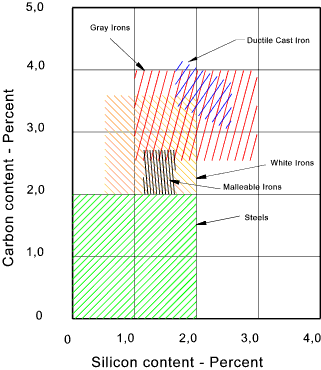| |
| These Pages include various standards. To confirm the status of any standard, identify the replacement standard if it is obsolete and/or purchase the standard please use. It is also possible to become a BSI member and obtain copies of the Standards at much reduced prices. |
Matter Index Ferrous Metals
|
Introduction Iron and its alloys is the most widely used material used in mechanical engineering.
This page include notes on the different methods used to produce the metal
from the raw materials. Pig Iron and recycled scrap metal is the basic feedstock to all the iron steel making processes.
Pig Iron is generally produced continuously in blast furnaces from a feedstock of
iron ore, coke, lime etc. The resulting pig iron is impure with a carbon content at about 4% and up to 4%
total of silicon, manganese, phosphorus and sulphur.
The pig iron and scrap are used to produce cast iron, and steel.
Cast iron......Cast Iron Notes Cast Irons are a family of ferrous metals with a wide range of properties produced by
being cast into shape as opposed by being formed. " Cast Irons contain
2% to 4% Carbon and 1% to 3% Silicon. Other elements are used to control
specific properties. Cast irons have a wide range of mechanical properties
which make them suitable for use in structural components and components used for
bearings. The wide spread use of cast iron is as a result of its low cost
and versatile properties. Wrought iron Wrought Iron is no longer produced in commercial quantities, the wrought iron that survives
contains less than 0,035 percent carbon. It therefore consists essentially of ferrite,
but its strength and malleability are reduced by entrained puddling slag, which is
elongated into stringers by rolling. As a result, breaking a bar of wrought iron
reveals a fibrous fracture not unlike that of wood. The other elements present are
silicon (0,075 to 0,15 percent), sulfur (0,01 to 0,2 percent), phosphorus (0,1 to 0,25 percent),
and manganese (0,05 to 0,1 percent). This relative purity is the reason why wrought iron has a reputation for good corrosion
resistance. Steel .....Plain Carbon Steel Notes Steel is by definition an alloy of iron and carbon in which the carbon content ranges
up to 2 percent (with a higher carbon content, the material is defined as cast iron).
By far the most widely used material for building the world's infrastructure and
industries, it is used to fabricate everything from pins to oil tankers. The main
reasons for the popularity of steel are the relatively low cost of making, forming, and
processing it, the abundance of its two raw materials (iron ore and scrap), and
its unparalleled range of mechanical properties. Alloy steels........Alloy Steels Notes Plain carbon steel is produced with a wide range of mechanical properties with comparatively
low cost. To extent the range of properties of steel alloys have been
developed. The benefits resulting include
The principle elements that are used in producing alloy steel include nickel, chromium,
molydenenum, manganese, silicon and vanadium. Cobalt , copper and lead are also used as
alloying elements. Cast Steels.. Reference Standards BS 3100:1991 ...Specification for steel castings for general engineering purposes:
BS EN 10213-1:1996...Technical delivery conditions for steel castings for pressure purposes. General BS EN 10213-2:1996...Technical delivery conditions for steel castings for pressure purposes. Steel grades for use at room temp. and at elevated temp. BS EN 10213-3:1996...Technical delivery conditions for steel castings for pressure purposes. Steels for use at low temperatures BS EN 10213-4:1996...Technical delivery conditions for steel castings for pressure purposes. Austenitic and austenitic-ferritic steel grades BS 3146-1:1974 ...Specification for investment castings in metal. Carbon and low alloy steels
Steel castings are normally used in the annealed or normalised state. However when higher strength
steels or steels with other enhanced properties are required a full regime of heat treatment options are available. Low carbon steel castings
are often produced for case hardened products which have hard surfaces with tough ductile cores.
It is important to note that thin sections are generally stronger than thick section and
casting design and heat treatment processes should be optimised to ensure that the final manufactured cast
item has acceptable physical properties throughout. |
Relevant Steel Links
|
|
